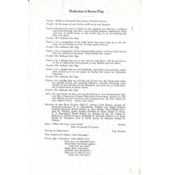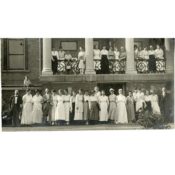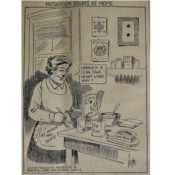
By Stephanie Hess, Northfield-Rice County Digital History Collection, January 2018
On April 6, 1917, the United States entered World War I. In very short order, Americans across the country began to mobilize soldiers, supplies, and support for the war. While all men between the ages of 21 and 31 registered for the draft and prepared for service in the national army or navy, the rest of the country also found ways to serve during wartime. People in Northfield and its surroundings in Rice County were called to “do their bit.”
The first thing that the country needed from its citizens was money. The government had to draft, clothe, train, and equip millions of soldiers. They used a combination of taxation and government bond sales to finance the war. In May 1917, the first of five national Liberty Loan drives of the war began.
Local committees in Northfield went out into the community to get pledges of support from their neighbors. Patriotic citizens who had purchased these bonds proudly wore buttons and displayed window stickers for all to see. Newspapers urged everyone to participate and reported on the success of each drive.
Northfielders also learned that increasing food production and conservation would help win the war. Farms were called upon to send flour and meat overseas, not only for suffering Europeans but also for their own soldiers. Housewives learned new methods of preserving the food they grew. They also began to create meals using wartime recipes that utilized more potatoes and corn.
By the end of the war, households in the Northfield area were eating less sugar and fats. Most followed government guidelines for wheatless and meatless days every week. Students at St. Olaf and Carleton Colleges attended classes on food science, first aid, and home nursing.
Many Northfield women volunteered for the local chapter of the American Red Cross and contributed their time and talents to knitting clothes for soldiers, rolling bandages, and fundraising. Others became leaders within organizations like the YMCA to support the soldiers in ways the military could not.
Families and community groups recognized the service of their local boys through starred service flags and pins, and wrote them regular letters with stories of home. In order to win this “war to end all wars,” American leaders needed total support from the home front, and from Northfield, they received it.
Primary Sources
Discussion Questions
When you look at the individual items in the Northfield-Rice County Digital History Collection, use the zoom-in tool to view details in the images or more easily read the documents. Use the tab labeled “TEXT” to read full transcriptions of the documents.
- How did World War I affect the lives of children in Northfield? In what ways could they contribute to the war effort? Read Ruth Pritchard’s childhood home front story in the Waterford Servicemen booklet among others to get some ideas.
- Why was it so important for the home front to support the war in the ways described above?
- Take a look at the Golden Palace War Flours advertisement. Think of some ways the war would have hurt businesses like theirs, and also ways that they benefited from it.
- Do you think that Americans could have helped win the war as quickly as they did (the war was over on November 11, 1918) without home front support? Why?
- Can you think of any reasons why someone might choose NOT to support the war’s fundraising drives or other patriotic efforts? What are they?
- What tools did the government use to encourage its citizens to support the war?
- Even though the fighting stopped in Europe on November 11, 1918, many of these home front efforts continued well into 1919. Why do you think that was the case?
- Propaganda is a way to promote or publicize a particular cause or point of view. Can you think of ways that propaganda can be used “for good”? And ways it can be used “for evil”? Which of the documents in this set do you think are propaganda? Why?
- In what ways can you see women’s roles changing during wartime?
- Identify ways in which life in Northfield during World War I is similar to how it is today, and how it is different.
Related Items in the Northfield-Rice County Digital History Collection
Arthur Houston’s World War I diary
Bulletins for the Baptist, Congregational, and Methodist Churches during the war
Fredrick Heiberg letters and postcards
Homer Mason’s account of his experiences overseas
Homer Mason letters and postcards
Portraits of servicemen from the Northfield area
Record of Soldiers in World War I
St. Olaf Red Cross Unit in parade
Selection of individual service records for area servicemen
Additional Resources for Research
Eighmey, Rae Katharine. “Food will win the war: Minnesota conservation efforts, 1917-1918.” Minnesota History, Minnesota Historical Society. 59.7: 272-286. Web. 26 January 2018.
Eighmey, Rae Katharine. “Liberty Gardens, 1917-1919,” MNopedia, Minnesota Historical Society. 20 April 2016. Web. 26 January 2018.
Goetz, Kathryn R. “Women on the World War I home front,” MNopedia, Minnesota Historical Society. 20 April 2016. Web. 26 January 2018.
Nathanson, Iric. World War I Minnesota. Charleston, SC: The History Press, 2016.
Northfield News issues, 1917-1918. Northfield, Minnesota. Available online through the Minnesota Historical Society’s Digital Newspaper Hub [filter by city and year]. Web. 31 January 2018.
Sutch, Richard. “Liberty Bonds: April 1917-September 1918,” Federal Reserve History. 4 December 2015. Web. 30 January 2018.
Urban, Carla. World War I on the Minnesota Home Front Primary Source Set, Minnesota Digital Library. Web. 26 January 2018.
World War I and the American Red Cross. American Red Cross. Web. 26 January 2018.
World War I in Northfield and Rice County Collection Guide. Northfield-Rice County Digital History Collection. Web. 31 January 2018.
“WWI: Minnesota in the Great War: Minnesota’s Home Front” Library Guide, Minnesota Historical Society. 17 January 2018. Web. 30 January 2018.
NOTE: To see all of the World War I-era digitized items from the Northfield area, visit the Northfield-Rice County Digital History Collection’s online database.
Primary Source Analysis
Here are some tips for analyzing the primary sources found above and throughout the DHC. For each source, ask students to indicate:
- the author’s point of view
- the author’s purpose
- historical context
- audience
For inquiry-based learning, ask students to:
- explain how a source tells its story and/or makes its argument
- explain the relationships between sources
- compare and contrast sources in terms of point of view and method
- support conclusions and interpretations with evidence
- identify questions for further investigation
Additional Tools
- Document Analysis Worksheets from the National Archives
- Teaching with Primary Sources Videos and Sets from the Minnesota Historical Society
- Using Primary Sources from the Library of Congress
Minnesota Education Standards
Here is a list of education standard codes for benchmarks that can be explored using this Primary Source Set.
- 0.4.1.2.1
- 1.4.1.2.1, 1.4.1.2.2, 1.4.2.4.1, 1.4.2.4.2
- 2.4.1.2.1, 2.4.2.4.2
- 3.4.1.1.2, 3.4.1.2.1, 3.4.1.2.2
- 5.4.1.2.1, 5.4.1.2.2, 5.4.2.3.1
- 6.4.1.2.1, 6.4.4.20.5
- 7.4.1.2.1
- 9.4.1.2.1, 9.4.1.2.2, 9.4.3.12.1, 9.4.4.20.9
- 1.8.7.7
- 2.8.7.7
- 3.2.7.7, 3.6.2.2, 3.6.7.7, 3.6.8.8, 3.8.2.2, 3.8.7.7, 3.8.8.8
- 4.2.7.7, 4.6.2.2, 4.6.7.7, 4.6.8.8, 4.8.2.2, 4.8.7.7, 4.8.8.8
- 5.2.7.7, 5.6.2.2, 5.6.7.7, 5.6.8.8, 5.8.2.2, 5.8.7.7, 5.8.8.8
- 6.12.1.1, 6.12.2.2, 6.12.4.4, 6.12.7.7, 6.12.9.9, 6.14.2.2, 6.14.7.7, 6.14.8.8
- 9.12.1.1, 9.12.2.2, 9.12.4.4, 9.12.7.7, 9.12.9.9, 9.14.2.2, 9.14.7.7, 9.14.8.8
- 11.12.1.1, 11.12.2.2, 11.12.4.4, 11.12.7.7, 11.12.9.9, 11.14.2.2, 11.14.7.7, 11.14.8.8
Send us feedback about this primary source set.
This publication was made possible in part by the people of Minnesota through a grant funded by an appropriation to the Minnesota Historical Society from the Minnesota Arts and Cultural Heritage Fund. Any views, findings, opinions, conclusions or recommendations expressed in this publication are those of the authors and do not necessarily represent those of the State of Minnesota, the Minnesota Historical Society, or the Minnesota Historic Resources Advisory Committee.


















